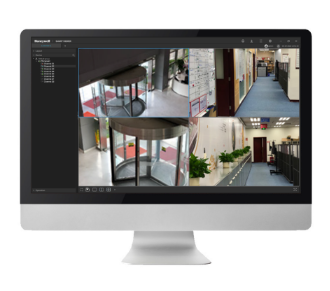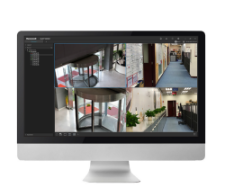CAMERAS

HONEYWELL SMART VIEWER FOR 35 SERIES NVRs
PRODUCT DESCRIPTION
Honeywell Smart Viewer (HSV) is designed to connect and manage multiple 35 Series Embedded NVRs.
Featuring a user-friendly interface, HSV can be deployed for device management, configuration, video live view, playback, event management, PTZ control, fisheye camera de-warping, and E-map. This view also includes support for multiple monitors, various display layouts, customized views and tours, two-way audio, and global P2P remote connection for efficient monitoring and operation. HSV supports up to 2048 cameras and multiple NVRs, making it ideal for medium to large-scale video surveillance systems. With HTTPS and TLS 1.2 encryption for streaming and communication between HSV and 35 Series NVRs, customers can enhance compliance, reduce potential liability costs, and benefit from end-to-end encrypted and secure video surveillance.


For 35 Series NVRs
Honeywell Smart Viewer (HSV) is designed to connect and manage multiple 35 Series Embedded NVRs.
Featuring a user-friendly interface, HSV can be deployed for device management, configuration, video live view, playback, event management, PTZ control, fisheye camera de-warping, and E-map. This view also includes support for multiple monitors, various display layouts, customized views and tours, two-way audio, and global P2P remote connection for efficient monitoring and operation. HSV supports up to 2048 cameras and multiple NVRs, making it ideal for medium to large-scale video surveillance systems. With HTTPS and TLS 1.2 encryption for streaming and communication between HSV and 35 Series NVRs, customers can enhance compliance, reduce potential liability costs, and benefit from end-to-end encrypted and secure video surveillance.
MARKET OPPORTUNITIES
An intuitive user interface, comprehensive features, HTTPS encryption, multi-site management, and global P2P-enabled remote connection make this video management viewer ideal for a wide range of medium and large-scale security applications. It prioritizes efficiency, ensures compliance, and protects data
FEATURES
- Supports Honeywell 35 Series Embedded NVRs for connection anytime, anywhere (local, remote, global P2P).
- Enables multi-NVR management, supporting up to 2048 video channels.
- Features two-way audio through 35S NVR with 35S cameras.
- Supports up to 64 live view windows on a single screen.
- Compatible with Windows® 10 (64-bit).
- Automatically adjusts streaming size to save decode and streaming bandwidth.
- Capable of receiving video analytic events from 35S series cameras through 35S NVR.
- Offers dual monitor configuration for displaying live view, tours, E-map, or event views.
- Allows editable display information on live view.
- Ensures end-to-end HTTPS stream encryption.
- Manages video recording and playback.
- Handles event management and event triggers.
- Facilitates device management and PTZ control.
- Supports MFZ and digital zoom.
- Enables fisheye dewarping and E-map integration.
SYSTEM DIAGRAM

specifications
SYSTEM
MANAGEMENT
PC/MAC REQUIREMENT
Request a Quote
Learn More From
Frequently Asked Questions
Multimode fiber commonly comes in 50/125 μm or 62.5/125 μm core/cladding dimensions, with bandwidth capacities ranging from 200 MHz to 2 GHz, depending on the grade. Multimode systems typically support transmission distances of up to 5 km, making them suitable for short- to medium-range applications.
In contrast, singlemode fiber—usually 9–10/125 μm—offers significantly lower attenuation and effectively unlimited bandwidth, supporting links over 150 to 200 km, especially when paired with optical amplifiers and advanced transceivers.
While singlemode fiber is less expensive per meter, its associated transceivers and equipment tend to cost more than their multimode counterparts. That said, singlemode devices are generally compatible with both singlemode and multimode fiber, whereas multimode equipment works only with multimode fiber.
Let me know if you’d like this turned into a quick-reference table or visual comparison—it’d make a solid inclusion for a fiber deployment guide.
The link budget is the difference between the transmitter’s output power and the receiver’s sensitivity. This budget must account for all signal losses along the path, including:
- Fiber attenuation due to the transmission medium
- Connector losses, such as those at patch panels or equipment interfaces
- Splice losses from mechanical or fusion joints
- Link margin, which provides a buffer for unforeseen variations
The link margin typically ranges from 2–3 dB in tightly controlled environments to up to 10 dB in more variable conditions. It is designed to accommodate:
- Component aging (e.g., light sources may degrade and lose up to 3 dB over time)
- Temperature variations affecting transmitter output or receiver sensitivity (up to 3 dB may be needed for thermal fluctuations)
- Physical cable damage and repair-induced losses (usually minor, but more relevant in harsh or industrial settings)
Always design your system for worst-case scenarios to ensure reliability. However, don’t overlook the best-case condition either—some optical receivers may exhibit erratic behavior if the incoming signal is too strong.
First, verify the optical signal strength along the link. Use an optical power meter to measure the received power at the fiber’s end point. Typical transmit levels range from –8 dBm to –15 dBm, while the receiver sensitivity is around –31 dBm, giving you a link budget of approximately 16 dB. This margin supports transmission distances of up to 10 km on singlemode fiber and about 3–5 km on multimode fiber.
If the measured power falls below the receiver sensitivity, there’s a strong likelihood of issues with the installed fiber. Ideally, initial OTDR readings should have flagged such faults.
If not, inspect the patch cords currently in use for possible defects or misalignment. A frequent oversight is the use of mismatched patch cords.
Multimode fiber types are classified by the ISO/IEC 11801 standard into five main categories: OM1, OM2, OM3, OM4, and OM5. Each type differs in core size, bandwidth, supported data rates, and maximum transmission distances. Here’s a quick breakdown:

- OM3 and OM4 are laser-optimized and widely used in modern data centers.
- OM5 supports shortwave wavelength division multiplexing (SWDM), enabling multiple wavelengths over a single fiber for higher capacity.
- All OM types are backward compatible in terms of connectors, but mixing core sizes (e.g., OM1 with OM3) can cause performance issues.
